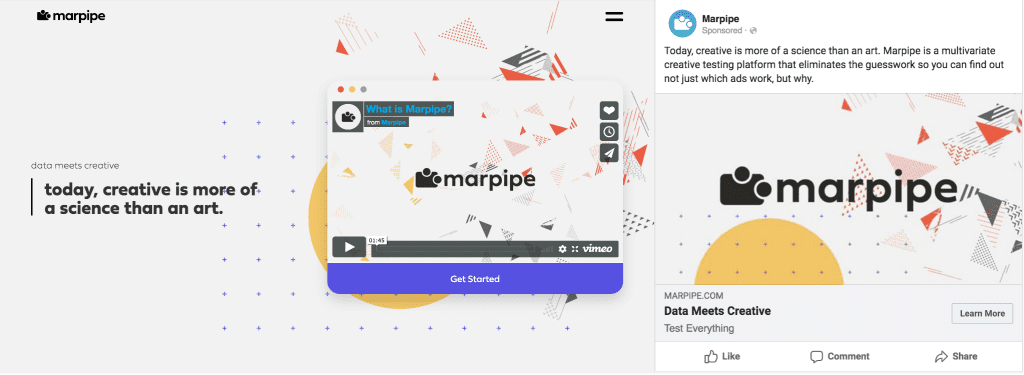You love split tests. We all do – who doesn’t want to improve a little every day? Even rapper Lil Uzi Vert does it. But most people miss out on a huge opportunity that each split test provides. A single A/B test only offers a single result, but that result can be applied to your ads, your branding, your marketing materials, and more.
How to Use Website Optimization Data for Your Ads
Tons of articles have been written on what you can test. The answer is essentially everything.
So let’s say you’ve tested a few high-level components: CTA, color palette, and messaging. You run some A/B tests and you learn that your best CTA is ‘Apply Now’, the color palette is green, and your most effective messaging includes social proof, specifically how many people have recently bought your latest product.
Great! Your website improved conversions by 282%.
So what’s next? Test more?
Yes. You should definitely test more, but you can also get substantially more value out of your previous tests.
Imagine you’re the customer. You stumble upon a new product you adore. Call it a water bottle with temperature control. You find the product through Google, go to the site, fall in love with the feel of it all, the green colors, the inviting copy, the community of other buyers. You order one for yourself.

Now imagine you’re browsing Facebook, reading about your friends’ happy, successful lives when you see an ad on the sidebar for the water bottle you just bought. It’s got that same lovable green palette, inviting CTA, and ‘14,000,000 Happy Drinkers’ message.
Now that rewarding feeling has returned, you’re thinking of your friends, and you just might need a gift for Jessie’s upcoming birthday. Back to the site, back into the branding, back to the cart for more. Conversions doubled.
Based on the data we’ve seen from running hundreds of multivariate tests, we see that findings from statistically significant tests carry across to other channels, so it’s important to understand that results from proper tests have omnichannel implications.
How to Use Ad Creative Data for Ecom Branding
Let’s say you were satisfied with your first 3 tests, but you want to know more. You’re addicted to the thrill of the test and learn cycle. You want to know what price people will pay, what packaging to use, what products to display…
You want to run a multivariate test. This kind of test is best suited to advertising. To learn more on the process, you can read a bit about it on Marpipe’s blog, but it’s essentially an evolution of a/b testing wherein all creative variables are controlled for and measured.
Rather than testing large differences on a small scale (as in a/b tests), you run small differences on a large scale. This way, you can find small, discrete differences. For example, taking your green color palette and finding a precise shade, say: #32a852 that improves ROI 14%.
You can use MVT to test dozens of options with low-cost ads. You might have 10 different prices, 5 different products, and 3 different product packaging options. To learn what your audience wants the most, you make ads with every possible combination of items : 10 x 5 x 3 = 150 ads. Run them all live and you’ll have an incredible amount of creative data.
The fun part is combining that ad data with your website data to optimize branding.
Let’s say you’re a beverage company. You found out that people are most willing to purchase your nutrition drink when it’s packaged in triangular 3-packs, sold for $30.
Earlier, you learned that green color palettes, CTA: ‘Apply Now’, and social proof messaging outperform all other variants.
For consistent, effective branding, you can use those 5 data points for everything you create.

And that’s how to make high-quality, data-driven branding. Branding at its core is about consistent imagery and messaging.
If your website, ads, content, marketing materials, in-store activations, packaging, and every other form of communication carries the same message and imagery, you’ve got a brand. If your message and imagery decisions are all data-driven, i.e., chosen based on evidence from your a/b or multivariate tests, then you have data-driven branding.
Conclusion
CRO is an excellent starting point for your overall marketing and branding strategy. Through a series of a/b and multivariate tests, you can collect data to support your creative decisions. Rather than aiming in the dark, hoping to get purchases, subscribers, engagement– test everything. Even small changes can have huge impacts because creative data can be used across any platform online, offline, or in line.
Create a free account or sign in to your existing one, check out all the amazing new features and collect feedback!
Share this
Written by

John Doe
Brett Friedman is Director, Marketing & Sales at Marpipe, the world’s first multivariate testing platform for ad creative. He’s helped run thousands of creative tests, as well as hundreds of personal tests in his life. You can most easily reach him on LinkedIn.












